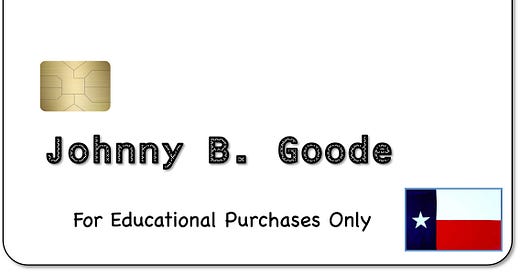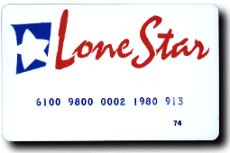Be forewarned, this is a long post. There’s just a lot to cover about how an ESA should really work in Texas.
Education Savings Accounts are relatively young, and they’re practically newborns when it comes to large scale, universal programs. Because there was a lot of initial resistance to school choice, states like Florida which were the true pioneers of this effort started with small programs with lots of restrictions and rules and limited eligibility and grew from there.
But the surge in school choice programs over the past 2 years has created the need for a different operating paradigm. Systems that were workable with a few thousand families can be brought to their knees when there are 500,000 participants (which about how many applicants Florida had to its program this year).
Texas, with over 6 million school age kids, could quickly become one of the largest programs in the country. This prospect makes it essential to design a program that can expand to meet the demands of parents. We need to learn from the successes and challenges of states like Florida and Arizona that have paved the way.
Here’s how I think Texas can create an accessible, scalable program.
Enter the SABER Card
SABER stands for Student Access to Broader Education Resources. (It is also the Spanish word for “To Know.” Nice.)
The parent of every child that gets an education savings account would be issued a SABER Card in the name of that child. Think of it like a prepaid debit card, loaded with money by the state which can only be spent on certain pre-approved, education-related expenses. It would be accepted by schools to pay tuition, grocery stores to pay for instructional materials like paper and crayons, tutors to pay for tutoring services, ride share companies to pay for transportation, testing companies to pay for assessments, and so on.
The child’s name is on the card, and it can only be used to buy educational goods and services for that child. The card could not be used to buy food, beverages, durable goods (more on this below), or anything that does not have an educational purpose.
Of course, there’s already a state program that works like this: the Lone Star Card, Texas’ version of the Electronic Benefits Transfer (food stamp) program.
The Lone Star Card can only be used for specific purchases, such as food and non-alcoholic beverages. It cannot be used for beer, cigarettes, lottery tickets, Whataburgers, or other disallowed items. Users of the Lone Star Card go to the store, fill their basket with a variety of items - some allowed, some not - and at checkout swipe their card. Allowable items are paid for, and any balance for disallowed items must be paid for with another form of payment (cash or credit card) and is not subsidized by the state.
There are, of course, broad and intense disagreements on how much money should be provided through the Lone Star Card system, but there is almost universal agreement that the program is well-run and well-administered, with relatively little waste, fraud, and abuse.
Although it’s a large-scale program serving over 3 million beneficiaries, the Lone Star Card puts decision-making power in the hands of individual consumers, vendors broadly participate and respond to consumer demand, and management of the accounts is handled by third-party vendors who contract with the state.
We should use the same approach when it comes to paying education expenses in Texas through an ESA. It would be a simple and transparent approach, one controlled by parents within parameters established by the state.
So what could the SABER Card pay for? Here’s a starting point – a list that’s sort of a mashup of the allowable expenses detailed in SB8 and HB1 introduced last session:
Tuition and fees at accredited schools. This is standard fare for school choice programs. I expect the Texas program to rely heavily on accrediting agencies to assess school performance, rather than a centralized, state-wide accountability system. This decentralization strategy is a key feature of the SABER system.
Relying on accreditors (who are approved by the Texas Education Agency) to oversee schools gives the state lots of flexibility to encourage more supply and respond to innovations. There are already well-established accrediting agencies like TEPSAC (the Texas Private School Accreditation Commission), but there are also other accreditors that specialize in certain kinds of programs who could play an important role in driving innovation, and I expect more to emerge over time. For instance, alternative accreditors could be instrumental in enabling and overseeing microschools - schools that are limited scope and time which are a major source of innovation in other states. (One example is the Black Mothers’ Forum in Arizona.)
A microschool that focuses, say, on computer technology or STEM or the arts or vocational training should not be required to teach an entire curriculum to be accredited. By creating alternative accreditation pathways, the SABER program will allow a more decentralized and flexible accountability mechanism, while maintaining ultimate accountability to the state.
Here’s another key feature that comes from relying on accreditation: every public district and charter school is already accredited by TEA, so the public system can create specialized programs and charge non-enrolled kids tuition. This feature creates a particularly exciting opportunity for collaboration between public schools and homeschoolers (the fastest growing segment of K-12 education in Texas). Homeschool kids are unlikely to ever enroll in a public school, but there are ways they could use the SABER Card to pay tuition for specific classes.
Imagine a homeschooler taking a chemistry class on an “a la carte” basis at their local public school. This arrangement would be good for schools (additional revenue they would not otherwise get), good for students (access to a specific class it might be hard to replicate in a homeschool environment due to facility constraints), and would help build more community and connection. This opportunity has really great potential in rural school districts, an idea I will return to in a later post.
Of course, Texas already allows homeschool participation in public schools on an a la carte basis: in athletics.
Due to a law the passed a few years ago by the Texas Legislature, homeschoolers can play on their local public school team without enrolling full time. And public schools in Florida are beginning to do more of this “unbundling” of their programs. It’s kind of like cable: not everyone wants to buy 132 channels; they’d be happier to buy only the streaming services they want, and those services are happy to sell to them directly. Others love the bundle. Giving parents the ability to choose is what this program is all about.
Bottom line: if it’s good enough for Friday Night Lights, it should be good enough for Tuesday Afternoon Art.
Fees for tutoring or teaching services. Some kids just need a little more help, and tutors give parents the ability to “top up” their kid’s education with one-on-one or small-group services that could be paid for with the SABER Card. There are also subjects that lend themselves more to a tutoring pedagogy: arts and music in particular fit this pattern. And for parents who want to “unbundle” their kids education as described above, tutoring can fill gaps that limited scope programs like microschools cannot fill. Giving parents this power to curate and manage their kid’s education is an important freedom provided by school choice programs.
One key question around tutoring is who should be allowed to tutor? Or, more precisely, who should be allowed to be paid as a tutor with the SABER Card? One way to frame this is to apply the criteria for approving a pharmaceutical: safety and efficacy.
For safety, tutors will need to be cleared through criminal database to make sure they’re not a convicted felon, and that they’re not on a list of people barred from working with kids. That’s pretty straightforward, and piggybacks on databases the state already maintains.
Efficacy is a little trickier. We don’t want to restrict tutors to only being certified or retired teachers (although they will certainly be included). But we also want to make sure that tutors have some knowledge of what they’re tutoring, otherwise it’s just a waste of money. I think a reasonable approach is to require some kind of certification - a degree or certificate or some form of credential or even certain kinds of job experience (being taught computer repair by a retired computer repair guy should certainly count, right?).
Ultimately, of course, we are relying on parents to assess whether a tutor is being effective. They are closest to the action and in the best position to monitor the performance of the tutor. Parents may not be experts on a particular subject, but they are experts on the most important subject: their children.
By design, then, tutoring qualifications need to be looser and more flexible than school accreditation. But there also needs to be a limit on the amount of unaccredited teaching is paid for by a SABER Card. That gets us into a discussion around homeschooling and ESA, which I will return to in a future post. For now what’s important is that for tutors there is some kind of certifier, just as for schools there is some kind of accreditor. Quality control in both cases is decentralized and distributed, and ultimately rests on parents.
Costs of instructional materials, such as books, school supplies, and curricula. This type of expense is where a SABER Card really shines. As in the case of the Lone Star Card, I’d expect a wide range of merchants to accept the SABER Card for these sorts of purchases. But the goods that can qualify as “instructional materials” are likely to be items that are universally needed consumables, like pencils, paper, protractors, and instructional plans.
This category has been a major problem in other states that have implemented ESAs, so it’s worth highlighting a couple of ways the Texas SABER Card will differ from what other states have tried.
The first difference is that most states implement some form of reimbursement, which allows parents to make purchases with their own funds and then seek reimbursement from the state. What seems absolutely clear from the experience of others is that reimbursement systems are a disaster. I will state unequivocally that Texas should not implement a reimbursement system. Period.
There are a couple of reasons why reimbursement systems go off the rails. The first is that reimbursement requires parents to figure out the rules determining what is acceptable and what is not, and then take a risk with their own money as to whether the state will pay them back. Putting parents in charge of interpreting administrative law is unrealistic - not because parents are stupid but because administrative law is often stupid, or at least highly counter-intuitive. And when parents get it wrong, they only find out after the money is out the door and they have no recourse. On the other hand, a SABER Card system, like an EBT system, will let parents know what is acceptable and what is not at the point of sale. There will be no confusion; if the SABER Card doesn’t pay for it, you know it and still have the option to pay yourself.
The second problem with reimbursements is that they are incredibly labor intensive. States that have these programs end up having to screen and decipher parents’ applications, and there are lots of corner cases that are difficult to adjudicate. Example: some public schools take field trips to places like SeaWorld, where they learn about marine biology. So should tickets to SeaWorld be paid for by an ESA? To be consistent with public schools, you would say yes. But what if the ticket was on a Saturday or Holiday? Do they have to go to some kind of presentation on marine biology to qualify, or can they just go on all the rides?
You can see how things things get complicated and take lots of time to figure out. That, in turn, leads to long delays in reimbursement. Low income families in particular are in a tough spot; they might be able to pay with a credit card, but their income means the interest rate is really high. So let’s say they make a totally clean and legit purchase on their credit care and apply for reimbursement. Because of the overall delays in processing, they don’t get paid for 90 days (yes, this is happening in other states). They finally get the check, but they’re out two months of interest charges because they couldn’t pay their card balance.
Anyway, you get the idea, but let me state it again: Texas should not implement a reimbursement system under any circumstances. More fundamentally, we shouldn’t need to. Our approach should be: if you want the state to pay for some item that your kid needs, then you need to use the SABER Card for the purchase.
Another Texas difference regarding purchase of instructional materials is that other states have given wide latitude to parents to make decisions about what to buy. A favorite example of mine is that one state was petitioned by the parents of a kid on the autism spectrum to purchase a chicken, because it helps their child focus. This expenditure was allowed and paid for by the kid’s ESA.
Texas should not allow this sort of direct expenditure on unusual or esoteric items. It’s not that chickens might not have an educational purpose - they can and I believe they probably did help that kid on the spectrum. (I should also add that my kids who are not on the spectrum went to a Montessori program that had chickens, so there’s that.) But the issue is not whether chickens can have an educational purpose; the issue is whether a system that allows parents to unilaterally decide to purchase chickens directly with a SABER Card is a good idea. I think it’s not.
But that doesn’t mean that things would be hopeless for educational chicken advocates. The right way to do this, in my opinion, is for parents to sign up for a program offered by an educational service provider that would provide chickens as part of the program. This step requires parents to find someone who runs such a program, or will work with them to create a new one. Parents then pay fees to the provider, who is responsible for buying and providing the chickens. But, crucially, that provider would be accountable to the entity that accredits or certifies them. It creates a check and balance in the system, while also allowing parents to pursue more innovative approaches without requiring state approval. Again, as with accreditation above, the goal is to decentralize and distribute the authority to oversee programs to a group of approved accreditors and certifiers.
I know the hardcore libertarians are probably saying just let parents spend money on whatever they want. But this ignores a crucial factor: we all have cognitive biases, and we can’t see them. However, if we have to convince someone else of something, it can help reduce the impact of those biases. Chickens are one thing, but what if parents think that they should be able to buy uranium to teach their kids about radioactivity? Maybe if parents can’t find a single education provider who is willing to work with them on something outside the norm, maybe the state should not be paying for that item.
So how would this work in the case of the autistic kid mentioned above? The truth is that the parents are going to have to negotiate with someone: are they better off negotiating with a centralized state agency, or a variety of providers who are likely to have the specialized knowledge needed to get the most out of the chickens?
Cost of academic assessments. In both SB8 and HB1, students participating in the program will be required to take an annual norm-referenced test. The vast majority of parents want such an assessment to track their kids’ academic progress, but the costs of these tests can be substantial. But parents can pay the fees using the SABER Card.
Transportation. One of the key lessons from both the charter school movement and the experience of other states running ESA programs is that transportation is often required to make choice accessible, particularly to low income families. In Texas, parents could use the SABER Card to pay for a bus service, or even for specialized ride sharing progams like HopSkipDrive.
Still, for all its flexibility, the SABER Card is still supposed to only be used for education. As such, I expect there will be items specifically excluded from SABER Card use. Such items might include:
Food and beverages. The SABER Card is intended for feeding children’s minds, not their bodies. Parents can and should feed their own kids, and there are already programs to provide meals to kids who need them (and the Lone Star Card fills this gap as well!).
Healthcare and medicine. Again, there are existing programs that can cover this area where needed, and education funds should not be diluted with paying directly doctors, hospitals, and pharmaceutical companies. Of course, schools are often required by law and accreditors to provide basic urgent care, and that’s fine as part of a bundled service (more on that below). And there are situations where special needs kids will need a physician to prescribe a particular assistance device. But the SABER Card should not be used to buy a bottle of Advil or pay for setting a broken arm.
Durable goods. This one will take some explaining. First, a durable good is defined by the Bureau of Economic Analysis as “a tangible product that can be stored or inventoried and that has an average life of at least three years.” So think about desktop computers, laptops, tablets, whiteboards, projectors, and so on. Expensive, long-lasting stuff.
These goods cannot be purchased using the SABER Card.
Wait, no computers? Aren’t they critical to education today? The answer of course is yes. Nevertheless, they cannot be purchased; they must be rented or leased, and those payments can be made with the SABER Card.
This sounds a little convoluted, but there’s a reason. Several actually. The first is that allowing parents to buy expensive goods that last a long time with the SABER Card tempts them to resell the item and pocket the difference. How could you stop a parent from buying a $2,000 laptop and selling it for $1,500 and keeping the money? This kind of scenario invites fraud and abuse. But if they’re leasing the laptop, the owner is the leasing company and they will have an interest in keeping track of it, and preventing parents from selling it. It also allows a market to develop at a variety of price points depending upon need for different kinds of equipment in different conditions.Second, parents often struggle to figure out the right piece of equipment. A lease allows the try something and switch if it isn’t working well. Children and technology both change quickly, and long-term commitments are hard to manage, even for professionals.
Third, the SABER Card is intended to cover operating costs, not capital expenditures. Mixing capex into an operating budget is almost always a bad idea; the temptation is to over-invest while you have a lot of money, and run short of funds late when you really need it. Renting and leasing smooth outlays, and put the equipment owner - the person most familiar with the good they own - in the position to take the residual risk.One final note on durable goods: I would love to extend this requirement to lease to textbooks. In many cases, schools provide textbooks (which is a form of bundled leasing), but in others families are forced to purchase really expensive new texts, and buy and sell in a secondary market. From a finance standpoint, this is an inefficient arrangement - a textbook rental company would have a lower cost of capital than the average Texas family.
Again, to reiterate: parents can pay for use of durable goods, they just won’t be able to use state money to purchase and own those goods.
Payments to family members. While there are no doubt situations where a sister, or aunt, or cousin would be a great tutor , there’s simply too much opportunity to abuse such a system because there would not be an effective price control. As a result, the SABER Card won’t be able to pay relatives directly for services. However, if a family member simply works as an employee of a tutoring service it would probably be fine. The tutoring service would be subject to audit and could lose their ability to participate if there was something fishy going on.
Whew, well that’s a lot of material, and there’s still more yet to explore. But if I was going to sum up in one sentence how the Texas ESA will work, it would be this:
Texas will create a payment card, the SABER Card, modeled on the successful Lone Star Card, but used to pay for education-related goods and services of participating children.
If it works for food, why can’t it work for education?











Very informative and thoughtful.
Thank you Leo!